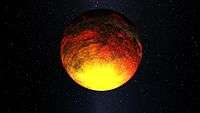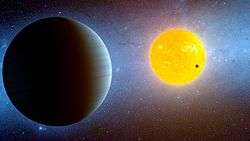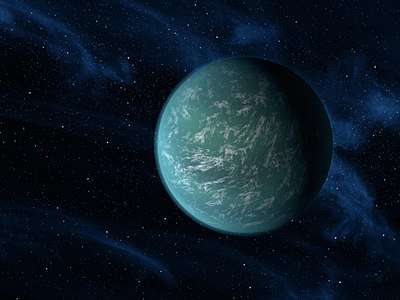Kepler-10
Kepler-10, formerly known as KOI-72, is a Sun-like star in the constellation of Draco that lies 187 parsecs (608 light years) from Earth. Kepler-10 was targeted by NASA's Kepler spacecraft, as it was seen as the first star identified by the Kepler mission that could be a possible host to a small, transiting exoplanet.[5] The star is slightly less massive, slightly larger, and slightly cooler than the Sun; at an estimated 10.4 billion years in age, Kepler-10 is almost 2.6 times the age of the Sun. Kepler-10 is host to a planetary system made up of at least two planets. Kepler-10b, the first undeniably rocky planet,[5] was discovered in its orbit after eight months of observation and announced on January 10, 2011. The planet orbits its star closely, completing an orbit every 0.8 days,[6] and has a density similar to that of iron.[5] The second planet, Kepler-10c, was confirmed on May 23, 2011, based on follow-up observations by the Spitzer Space Telescope. The data shows it has an orbital period of 42.3 days and has a radius more than double that of Earth, but a higher density, making it the largest and most massive rocky planet discovered as of June 2014.[2][7][8]
| Observation data Epoch J2000 Equinox J2000 | |
|---|---|
| Constellation | Draco |
| Right ascension | 19h 02m 43.0612s[1] |
| Declination | +50° 14′ 28.701″[1] |
| Apparent magnitude (V) | 11.157[2] |
| Astrometry | |
| Proper motion (μ) | RA: −18.394±0.045[1] mas/yr Dec.: 41.448±0.046[1] mas/yr |
| Parallax (π) | 5.3618 ± 0.0233[1] mas |
| Distance | 608 ± 3 ly (186.5 ± 0.8 pc) |
| Characteristics | |
| Spectral type | G[3] |
| Details | |
| Mass | 0.910 ± 0.021[2] M☉ |
| Radius | 1.065 ± 0.009[2] R☉ |
| Temperature | 5708 ± 28[2] K |
| Age | 10.6+1.5 −1.3[2] Gyr |
| Other designations | |
| Database references | |
| SIMBAD | data |
| KIC | data |
Nomenclature and history
Kepler-10 was named because it was the tenth planetary system observed by the Kepler spacecraft, a NASA satellite designed to search for Earth-like planets that transit, or cross in front of, their host stars with respect to Earth. The transit slightly dims the host star; this periodic dimming effect is then noted by Kepler.[9] After eight months of observation ranging from May 2009 to January 2010, the Kepler team established Kepler-10b as the first rocky exoplanet discovered by the Kepler satellite. Kepler-10 was the first Kepler-targeted star suspected of having a small planet in orbit. Because of that, verifying Kepler's discovery was prioritized by telescopes at the W.M. Keck Observatory in Hawaii. The discovery was successfully verified.[5] Although there had been many potentially rocky exoplanets discovered in the past, Kepler-10b was the first definitively rocky planet to have been discovered.[10]
The discovery of Kepler-10b was announced to the public at a winter meeting of the American Astronomical Society on January 10, 2011 in Seattle.[10] On May 23, 2011, the existence of Kepler-10c was confirmed at the 218th AAS meeting in Boston.[11]
Characteristics
Kepler-10 is a G-type star, like the Sun. With a mass of 0.895 (± 0.06) Msun and a radius of 1.056 (± 0.021) Rsun, the star is approximately 10% smaller than and 5% wider than the Sun. The metallicity of Kepler-10, as measured in [Fe/H] (the amount of iron in the star), is -0.15 (± 0.04); this means that Kepler-10 is about 70% as metal-rich as the Sun. Metallicity tends to play a large role in the formation of planets, determining if they form, and what kind of planet they will form.[12] In addition, Kepler-10 is estimated to be 11.9 billion years old and to have an effective temperature of 5627 (± 44) K;[3] To compare, the Sun is younger and hotter, with an age of 4.6 billion years[13] and an effective temperature of 5778 K.[14]
Kepler-10 is located at a distance of 173 (± 27) parsecs from the Earth, which equates to approximately 564 light years. Also, Kepler-10's apparent magnitude, or brightness as seen from Earth, is 10.96; it therefore cannot be seen with the naked eye.[3]

Planetary system
Per the usual exoplanet nomenclature, the first planet discovered to be orbiting Kepler-10 is called Kepler-10b. Announced in 2011, it was the first rocky planet identified outside the Solar system. The planet has a mass that is 3.33±0.49 times that of Earth's and a radius that is 1.47+0.03
−0.02 times that of Earth.[2] The planet orbits Kepler-10 at a distance of 0.01684 AU every 0.8375 days; this can be compared to the orbit and orbital period of planet Mercury, which circles the Sun at a distance of 0.3871 AU every 87.97 days.[15] Because the planet orbits so closely to its star, its eccentricity is virtually zero. It, thus, has an extremely circular orbit.[6]
Kepler-10c[7] was also discovered by NASA's Kepler Mission,[16] the second exoplanet found to orbit Kepler-10. Radial-velocity measurements of the body suggest that it has a mass of 17.2±1.9 Earth masses and a radius of 2.35 Earth radii, making it the largest known rocky planet as of 2014. Kepler-10c would orbit Kepler-10 at a distance of 0.24 AU every 45.29 days.[2]
Kepler-10d was discovered in 2017 and still has not been confirmed. It would orbit its parent star at a distance of 0.366 AU every 102±1 days. [17]
| Companion (in order from star) |
Mass | Semimajor axis (AU) |
Orbital period (days) |
Eccentricity | Inclination | Radius |
|---|---|---|---|---|---|---|
| b | 3.33±0.49 M⊕ | 0.01684 | 0.837495 | 0 | 84.8+3.2 −3.9° |
1.47+0.03 −0.02 R⊕ |
| c | 7.37+1.32 −1.19[18] M⊕ |
0.2410 | 45.29485 | 0 | 89.59+0.25 −0.43° |
2.35+0.09 −0.04 R⊕ |
| d (unconfirmed) | 5.7+1.9 −1.7 M⊕ |
0.366 | 102 ± 1 | ? | ?° | ? R⊕ |
See also
- Kepler Mission
- List of exoplanets
References
- Brown, A. G. A.; et al. (Gaia collaboration) (August 2018). "Gaia Data Release 2: Summary of the contents and survey properties". Astronomy & Astrophysics. 616. A1. arXiv:1804.09365. Bibcode:2018A&A...616A...1G. doi:10.1051/0004-6361/201833051. Gaia DR2 record for this source at VizieR.
- Dumusque, Xavier; Bonomo, Aldo S.; Haywood, Raphaëlle D.; Malavolta, Luca; Ségransan, Damien; Buchhave, Lars A.; Cameron, Andrew Collier; Latham, David W.; Molinari, Emilio; Pepe, Francesco; Udry, Stéphane; Charbonneau, David; Cosentino, Rosario; Dressing, Courtney D.; Figueira, Pedro; et al. (2014). "The Kepler-10 Planetary System Revisited by Harps-N: A Hot Rocky World and a Solid Neptune-Mass Planet". The Astrophysical Journal. 789 (2): 154. arXiv:1405.7881. Bibcode:2014ApJ...789..154D. doi:10.1088/0004-637X/789/2/154.
- "Notes for star Kepler-10". Extrasolar Planets Encyclopaedia. 2011. Archived from the original on 21 January 2011. Retrieved 13 March 2011.
- "Kepler-10". SIMBAD. Centre de données astronomiques de Strasbourg. Retrieved 2011-02-01.
- Perrotto, Trent J.; Hoover, Rachel (10 January 2011). "NASA'S Kepler Mission Discovers Its First Rocky Planet". Ames Research Center. NASA. Retrieved 13 March 2011.
- "Summary Table of Kepler Discoveries". NASA. 2011. Retrieved 13 March 2011.
- Fressin, François; et al. (2011). "Kepler-10c, A 2.2-Earth Radius Transiting Planet In A Multiple System". The Astrophysical Journal Supplement Series. 197 (1). 5. arXiv:1105.4647. Bibcode:2011ApJS..197....5F. doi:10.1088/0067-0049/197/1/5.
- Clavin, Whitney (June 2, 2014). "Astronomers Confounded By Massive Rocky World". NASA. Retrieved June 3, 2014.
- "Mission overview". Kepler and K2. NASA. Retrieved 9 August 2020.
- Richard A. Lovett (10 January 2011). "NASA Finds Smallest Earthlike Planet Outside Solar System". National Geographic Society. Retrieved 13 March 2011.
- "Kepler Spacecraft Shows That Smaller Planets Abound". Scientific American. 2011. Retrieved 2011-05-26.
- Henry Bortman (12 October 2004). "Extrasolar Planets: A Matter of Metallicity". Space Daily. Retrieved 13 March 2011.
- Fraser Cain (16 September 2008). "How Old is the Sun?". Universe Today. Retrieved 13 March 2011.
- Ed Grayzeck. "Sun Fact Sheet". Goddard Space Flight Center. NASA. Retrieved 13 March 2011.
- David Williams (17 November 2010). "Mercury Fact Sheet". Goddard Space Flight Center. NASA. Retrieved 27 February 2011.
- "NASA'S Kepler Mission Discovers Its First Rocky Planet". NASA. 2011-01-10. Retrieved 2011-01-10.
- "Three planets in the Kepler-10 system" (in Russian).
- Rajpaul, V.; Buchhave, L. A.; Aigrain, S. (2017). "Pinning down the mass of Kepler-10c: The importance of sampling and model comparison". Monthly Notices of the Royal Astronomical Society. 471 (1): L125. arXiv:1707.06192. Bibcode:2017MNRAS.471L.125R. doi:10.1093/mnrasl/slx116.



.jpg)